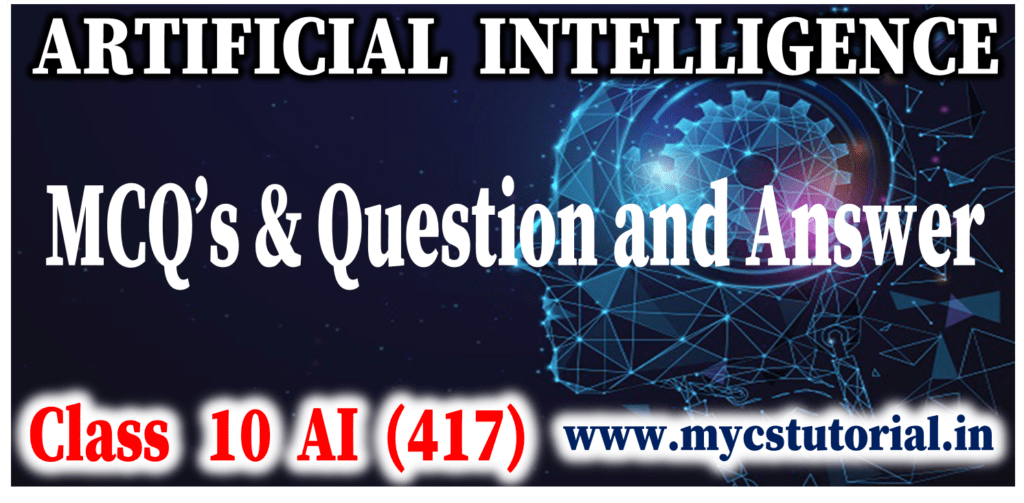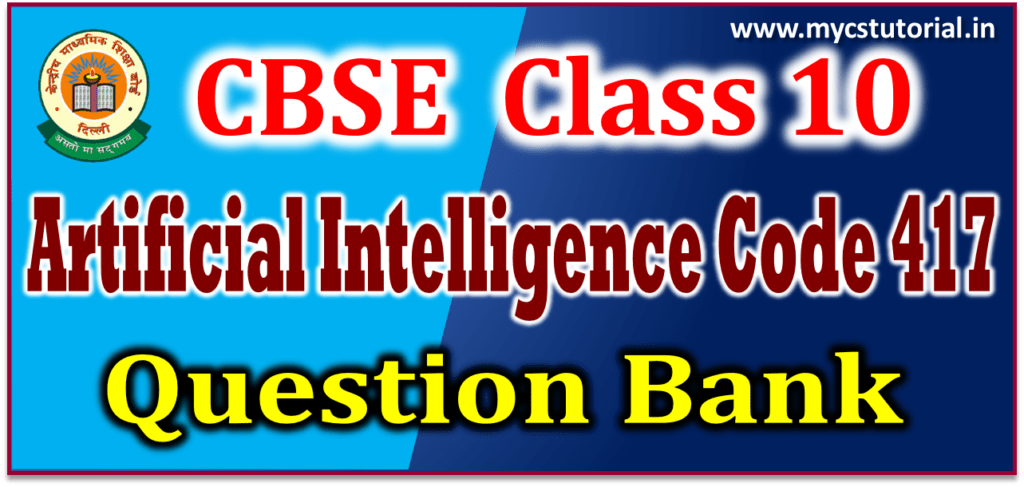Class 12 CBSE Board Question Paper 2023 Artificial Intelligence Code 843 – Solution
ARTIFICIAL INTELLIGENCE (SUBJECT CODE -843)
CBSE Board Question Paper with Solution for Class XII
(Session 2022-2023)
Max. Time: 2 Hours Max. Marks: 50
General Instructions:
- Please read the instructions carefully.
- This Question Paper consists of 21 questions in two sections: Section A & Section B.
- Section A has Objective type questions whereas Section B contains Subjective type questions.
- Out of the given (5 + 16 =) 21 questions, a candidate has to answer (5 + 10 =) 15 questions in the
allotted (maximum) time of 2 hours. - All questions of a particular section must be attempted in the correct order.
- SECTION A – OBJECTIVE TYPE QUESTIONS (24 MARKS):
i. This section has 05 questions.
ii. Marks allotted are mentioned against each question/part.
iii. There is no negative marking.
iv. Do as per the instructions given. - SECTION B – SUBJECTIVE TYPE QUESTIONS (26 MARKS):
i. This section has 16 questions.
ii. A candidate has to do 10 questions.
iii. Do as per the instructions given.
iv. Marks allotted are mentioned against each question/part.
Section – A
(Objective Type Questions)
Que 1. Answer any 5 out of the given 6 questions. 5 x 1 = 5
(I) Narcissistic personality disorder is characterized by which of the following conditions: [1]
i. People have an inflated sense of their own importance.
ii. A deep need for excessive attention.
iii. Admiration and lack of empathy.
iv. Introvert
(a) Only i (b) Both i and ii (c) i, ii and iii (d) i, ii, iii and iv
(II) ‘S’ in the acronym SMART in Goal setting stands for: [1]
(a) Strong (b) Segment (c) Specific (d) Special
(III) ______ is an economic process, where an idea is generated or an opportunity is created, refined, developed and implemented, while being exposed to uncertainty, to realise a profit by effective utilization of resources. [1]
(a) Entrepreneurs (b) Entrepreneurship development
(c) Entrepreneurship (d) Cluster intervention
(IV) In a spreadsheet software, an arrangement of cells in a vertical manner is known as: [1]
(a) Wroksheets (b) Workbooks
(c) Rows (d) Columns
(V) Which of the following is not an example of spreadsheet? [1]
(a) Microsoft Excel (b) LibreOffice Calc (c) OpenOffice Impress (d) Google Sheets
(VI) Which entrepreneur, out of the following, is essentially a manufacturer, who identifies the needs of customers and creates products or services to serve them? [1]
(a) Service entrepreneur (b) Industrial entrepreneur
(c) Agricultural entrepreneur (d) Technical entrepreneur
Que 2. Answer any 5 out of the given 6 questions. 5 x 1 = 5
(I) A training set is a set of _________ data in which the outcomes are already known. [1]
(a) current (b) instant (c) historical (d) output
(II) _______ involves a combination of three key elements, that help to explain the audience what’s happening in the data in an engaging and entertaining manner. [1]
(a) Data Analysis (b) Data Visualization (c) Data Storytelling (d) Data Narrative
(III) Match the following step of AI project given in column ‘A’ with its exact sequence given in column ‘B’. [1]
| Column – ‘A’ | Column – ‘B’ |
| 1. Evaluation & refinements | A. Second Step |
| 2. Problem Definition | B. Fifth Step |
| 3. Data gathering | C. First Step |
| 4. Deployment | D. Fourth Step |
| 5. AI model construction | E. Sixth step |
| 1 | 2 | 3 | 4 | 5 | |
| (a) | D | E | A | B | C |
| (b) | C | B | A | E | D |
| (c) | B | C | A | E | D |
| (d) | E | D | B | C | A |
(IV) In AI development which of the following framework is used? [1]
(a) Ptyhon (b) TensorFlow (c) Visual Basic (d) C++
(V) All the algorithm in machine learning rely on minimizing or maximizing a function, called as _________. [1]
(a) Objective Function (b) Focal Loss (c) Loss function (d) Gradient Descent
(VI) Which of the following is incorrect? [1]
(a) The testing phase is essentially an iterative process.
(b) The first fundamental step when starting an AI initiative is scooping,
(c) In scoping phase, its, crucial to precisely define the strategic business objectives and desires outcomes of the project.
(d) Test data should include all relevant subsets of training data.
Que 3. Answer any 5 out of the given 6 questions. 5 x 1 = 5
(I) When visuals are applied to data, they can _______ the audience to the insights that they wouldn’t perceive without the charts or graphs. [1]
(a) engage (b) explain (c) enlighten (d) change
(II) It is believed that there is a ______ in the data, then AI development techniques may be employed. [1]
(a) pattern (b) program (c) language (d) logic
(III) Assertion (A): It’s crucial to precisely define the strategic business objectives and desired outcomes of the project, select align all the different stakeholders’ expectations, anticipate the key resources and steps, and define the success metrics.
Reason (R) : Selecting the AI or machine learning use cases and being able to evaluate the return on investment (ROI) is critical to the success of any data project. [1]
(a) Both (A) and ® are true and (R) is the correct explanation of (A)
(b) Both (A) and ® are true and (R) is not the correct explanation of (A)
(c) (A) is true, but (R) is false.
(d) (A) is false, but (R) is true.
(IV) Which of the following shows the audience where to look and what not to miss and also keeps the audience engaged? [1]
(a) data (b) narrative (c) charts (d) story
(V) Once the relevant projects have been selected and properly scoped, which of the following phase will be the next step of the machine learning lifecycle? [1]
(a) Problem Scoping (b) Deployment
(c) Design (d) Testing
(VI) Which of the following is the first step of an AI Model Life Cycle? [1]
(a) Build (b) Scoping (c) Design (d) Testing
Que 4. Answer any 5 out of the given 6 questions. 5 x 1 = 5
(I) Which of the following is the most preferred language for building an AI model? [1]
(a) Python (b) VB (c) Java (d) C++
(II) Study the following graph:

What does the line in the above figure represent?
(a) Actual values (b) Set of predicted values (c) It represents the error (d) Values at Y axis
(III) First four steps of wiring Python code to find out RMSE values of the model are given here. Arrange them in proper order – [1]
1. Splitting the data into training and test
2. Reading the data
3. Fitting simple linear regression to the training set.
4. Import required libraries.
(a) 2 – 4 -1 -3 (b) 4 – 3 – 2 – 1 (c) 1 – 2 – 3 – 4 (d) 4 – 2 – 1 – 3
(IV) Which of the following is NOT True for Testing? [1]
(a) The volume of test data should be very small.
(b) Data validation is important.
(c) Your testing team should test the AI and ML algorithms keeping model validation.
(d) Your team must create test suites that help you validate your ML models.
(V) Data storytelling is a ______ approach for communicating insights drawn from data. [1]
(a) iterative (b) procedural (c) sequential (d) structured
(VI) Which of the following is NOT true for Train-Test Split Evaluation? [1]
(a) The procedure involved taking a dataset and dividing it into two subsets.
(b) The train-test procedure is appropriate when there is a larger dataset.
(c) The objective is to estimate the performance of the user.
(d) It can be used for classification or regression problem.
Que 5. Answer any 5 out of the given 6 questions. 5 x 1 = 5
(I) Stories create _______ experience that transport the audience to another space and time. [1]
(a) visualizations (b) engaging (c) testing (d) necessary
(II) Which of the following is incorrect? [1]
i. A capstone project is a project where students must research a topic independently to find a deep understanding of the subject matter.
ii. The initial part of the project of academic program is knows as capstone project.
iii. The final project of academic program, integrating all of the learning from the program is called capstone project.
(a) i and iii only (b) ii and iii only (c) ii only (d) i, ii and iii
(III) Which of the following is an example of a development tool used in building an AI model? [1]
(a) C++ (b) Anaconda (c) Linux (d) Scratch
(IV) Identify the correct statements from the following: [1]
i. Data modeling focuses on developing modes that are either descriptive or predictive.
ii. A predictive model tries to yield yes/no or stop/go type outcomes.
iii. The data scientist will use a training set for descriptive modelling.
iv. Data modelling focuses on testing the project.
(a) i, ii, and iii (b) ii, iii and iv (c) i and ii (d) i and iv
(V) ________ is a design methodology that provides a solution-based approach to solving problems. [1]
(a) Classification (b) Design Thinking
(c) Recommendation (d) Computational
(VI) Which of the following is a key element of a data story? [1]
(a) audience (b) visuals (c) engage (d) information
Section – B
(Subjective Type Questions)
Answer any 3 out of the given 5 questions on Employability Skills. Answer each question in 20-30 words. 3 x 2 = 6
Que 6. With reference to ‘Five Factor Model’, mention any four parameters that describe an individual’s personality. [2]
Que 7. Define any two of the following personality disorders: [2]
(a) Avoidant (b) Dependent (c) Histrionic
Que 8. Differentiate between a row and a cell of a spreadsheet. [2]
Que 9. Write any four qualities that motivate an entrepreneur. [2]
Que 10. Briefly define the term competency. Mention any two Common Entrepreneurial Competencies. [2]
Answer any 4 out of the given 6 questions in 20-30 words each. 4 x 2 = 8
Que 11. Mention the names of any four stages of Design Thinking. [2]
Que 12. Explain the term Time series decomposition. [2]
Que 13. Give two points of difference between Cross-Validation and Train-Test Split. [2]
Que 14. Selecting the right analytical approach depends on the questions being asked. [2]
In the light of the above given statement, which type of questions can be asked for
(A) Classification approach (B) Descriptive approach.
Que 15. Name the main stages of AI Project Life Cycle. [2]
Que 16. Give two reasons why storytelling is so powerful. [2]
Answer any 3 out of the given 5 questions in 50-80 words each. 3 x 4 = 12
Que 17. Give steps to break down a problem into smaller units before coding. [4]
Que 18. The following is the diagram depicting for Foundational methodology for data science. [4]

The diagram is marked with A, B, C, D. Identify these four steps and briefly explain the significance of steps marks as ‘A’ and ‘B’.
Que 19. Explain AI project cycle and project scoping in detail. [4]
Que 20. (a) Mention the steps that can assist in finding compelling stories in the data sets. [2+2 = 4]
Que 20. (b) Which of the following (Option – A or Option – B) is a better data story? Give reason.
Option – A

Option – B

Que 21. Briefly explain the purpose of Data story telling. Also discuss the significance of each of the key elements in the process of Data story telling. [4]
Download Question Paper PDF -> Click here
By Anjeev Kr Singh – Computer Science Educator
Published on : February 24, 2023 | Updated on : November 27, 2024










